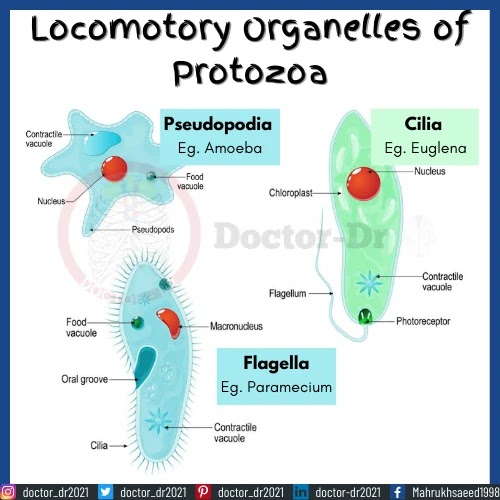Protozoa, single-celled eukaryotic microorganisms, inhabit a wide range of environments on our planet, from freshwater ponds to marine ecosystems, and even within soil and animal digestive systems. These microorganisms are renowned for their diverse morphology, physiology, behavior, and ecological roles. Among the intriguing aspects of protozoa, one of the most captivating is their means of movement, characterized by specialized organelles and various methods. This article delves into the world of protozoa, providing comprehensive insights into their locomotory organelles and diverse locomotion techniques. The discussion encompasses definitions, significance, and a thorough cladistic analysis.
Table of Contents
- What are Protozoa?
- Cladistic Analysis of Protozoa
- Locomotory Organelles of Protozoa
- Locomotion Methods of Protozoa
- Synthetic Cilia and Flagella – Biotechnological Application
- Conclusion
What are Protozoa?
- Protozoa, solitary eukaryotic microorganisms, inhabit diverse environments worldwide.
- Their classification is based on locomotory organelles, movement patterns, morphology, and ecological roles.
- Protozoa exhibit diameters ranging from 1 to 100 micrometers, with some larger species extending several millimeters.
- Reproduction in protozoa can occur through asexual or sexual means, and they develop complex structures like cysts or biofilms for survival in harsh conditions.
- The significance of protozoa in ecosystems cannot be overstated; they serve as essential primary producers, consumers, and decomposers.
- Protozoa form the bedrock of aquatic food chains, nourishing larger organisms like fish and plankton.
- In soil ecosystems, they play a pivotal role in nutrient cycling and the decomposition of organic matter.
- Notably, certain protozoa are substantial pathogens for humans and animals, causing diseases such as malaria, sleeping sickness, and giardiasis.
Cladistic Analysis of Protozoa
Cladistic analysis is an evolutionary biology technique employed to categorize organisms based on their genetic and evolutionary connections. Through cladistic analysis, numerous captivating insights into the evolution and diversity of protozoa have been unveiled. Within various flagellated protozoa groups, such as euglenoids and dinoflagellates, distinctive features like chloroplasts and bioluminescence have emerged over time. Complex behavioral and communication systems have evolved in organisms like ciliates and amoebas. Protozoa employ a range of locomotion strategies that adapt to their environment and lifestyle. Some protozoa, classified as sessile, remain stationary and depend on water currents or other organisms for sustenance and resources. Others lead a free-living existence, navigating their surroundings with specialized locomotory organelles. Certain protozoa take on a parasitic role, infiltrating and moving within their host organisms utilizing these locomotory organelles.
Locomotory Organelles of Protozoa
Protozoa possess various types of locomotory organelles, including cilia, flagella, pseudopodia, and undulating membranes.
Cilia and Flagella
- Cilia and flagella are slender, hair-like structures extending from the cell surface, facilitating cell movement through rhythmic waving.
- Many protozoa rely on these locomotory organelles, with cilia being shorter and more abundant in ciliated protozoa like Paramecium and Stentor.
- Notably, certain parasitic protozoa, such as the human respiratory parasite Balantidium coli, also feature cilia.
- Flagella, on the other hand, are lengthier and less numerous, commonly found in flagellated protozoa like Euglena and Trypanosoma.
- Flagella can also be observed in some free-living and parasitic bacteria, as well as in animal sperm cells.
Pseudopodia
- Pseudopodia refer to extensions of the cell membrane that a cell can extend in various directions, facilitating crawling or prey engulfment.
- Several protozoa employ pseudopodia, often referred to as "false feet," for their locomotion.
- These cell membrane extensions, known as pseudopodia, enable amoebas, for instance, to both move and feed.
- Parasitic protozoa, such as Entamoeba histolytica, also utilize pseudopodia as a means to invade host tissues.
Undulating Membrane
- Undulating membranes are distinctive structures present in certain flagellated protozoa, enabling cell movement through undulation.
- Protozoa like Trichomonas vaginalis feature undulating membranes, which are a specialized type of flagellum.
- These undulating membranes take on a flat, ribbon-like form, propelling the cell by undulating motion.
- Functioning akin to a wave, the undulating membrane facilitates efficient cell movement, particularly through thick substances like mucus.
Locomotion Methods of Protozoa
Protozoa, single-celled microorganisms renowned for their diverse traits in morphology, physiology, behavior, and ecology, offer a captivating study in their locomotory organelles and the varied locomotion techniques they employ. Protozoa adapt their locomotion strategies based on their surroundings and lifestyle.
These microorganisms feature four primary types of locomotory organelles: cilia, flagella, pseudopodia, and undulating membranes. The choice of locomotion employed by a protozoan depends on several factors, including its environment, the presence of obstacles, its size, and the nature of the substrate. For instance, cilia are effective for aquatic movement but less so on solid surfaces. Pseudopodia excel at crawling on solid surfaces, whereas flagella prove valuable in navigating liquid environments.
Ciliary and Flagellar Locomotion
- Cilia and flagella are slender, hair-like projections extending from the cell surface, propelling the cell forward through rhythmic waving.
- Cilia, shorter and more abundant than flagella, are present in ciliated protozoa like Paramecium and Stentor.
- Flagella, fewer in number but longer, are characteristic of flagellated protozoa such as Euglena and Trypanosoma.
- Additionally, flagella can be found in certain free-living and parasitic bacteria, as well as in animal sperm cells.
Pseudopodia Locomotion
- Pseudopodia are extensions of the cell membrane that cells can extend in various directions, facilitating crawling or prey engulfment.
- Amoebas, for instance, employ pseudopodia for both movement and feeding.
- Parasitic protozoa, like Entamoeba histolytica, also utilize pseudopodia as a means to infiltrate host tissues.
Locomotion Via Undulating Membrane
- Undulating membranes are specialized structures observed in certain flagellated protozoa, facilitating cell movement through undulating motions.
- These undulating membranes take on a flat, ribbon-like shape, enabling the cell to efficiently navigate through its surroundings via undulation.
- Protozoa like Trichomonas vaginalis harness undulating membranes to move effectively through viscous environments, such as mucus.
Understanding the locomotory organelles and methods employed by protozoa holds significant importance for several reasons. It is crucial, for instance, in comprehending the ecological roles played by protozoa in aquatic and soil ecosystems. Furthermore, it is pivotal in elucidating the pathogenic mechanisms of protozoan parasites and devising control strategies. Some anti-parasitic medications target protozoa locomotory organelles like flagella and cilia to prevent parasites from invading and moving within their hosts.
Synthetic Cilia and Flagella – Biotechnological Application
Research on protozoan locomotion has had a profound impact on the advancement of micro- and nanorobots featuring artificial cilia and flagella. These innovative robots hold promise for targeted drug delivery, microsurgery, and various biomedical uses.
- Designing artificial cilia and flagella presents challenges, as they must replicate the intricate movements seen in their natural counterparts, involving bending and twisting.
- Recent progress in micro- and nanotechnology, however, has facilitated the creation of synthetic cilia and flagella capable of mimicking the movements exhibited by their natural counterparts.
- Additionally, protozoa have been extensively explored for their potential biotechnological applications. Certain protozoa species have been found to produce industrially valuable enzymes like cellulases and proteases.
- Moreover, some protozoa have garnered attention for their potential role in biofuel production, owing to their ability to generate substantial quantities of hydrogen gas.
- The research into protozoan locomotion not only opens the door to novel biotechnological possibilities but also serves as a wellspring of inspiration for the development of new technologies.
Drug Delivery
Protozoa, characterized by their diverse locomotory organelles and methods of movement, offer a captivating avenue of research. This exploration has not only unveiled insights into their evolutionary relationships and diversity but also holds great promise across various domains, including medicine, biotechnology, and robotics.
- Protozoa's pivotal role in ecosystems underscores the significance of comprehending their locomotory organelles and modes of movement, enabling a better grasp of their ecological contributions and the formulation of effective control measures.
- The realm of biotechnology and robotics has witnessed remarkable advancements, thanks to protozoan locomotion research, opening doors to innovation and discovery.
- This understanding of protozoan locomotion serves as a cornerstone for the development of anti-parasitic drugs, strategically targeting protozoa locomotory organelles like flagella and cilia.
- Furthermore, protozoan locomotion research has spurred the creation of micro- and nanorobots equipped with synthetic cilia and flagella. These innovations hold potential in targeted drug delivery, microsurgery, and various biomedical applications.
- In essence, delving into the intricacies of protozoan locomotion is not only pivotal for unraveling their ecological roles in aquatic and terrestrial environments but also for propelling advancements in biotechnology and inspiring the genesis of cutting-edge technologies.
Conclusion
It's essential to acknowledge that the classification of protozoa has evolved significantly over time. Initial taxonomic approaches relied heavily on morphology, but the emergence of molecular techniques has paved the way for more precise phylogenies based on genetic data. Present-day molecular phylogenetic analyses have challenged the traditional categorization of protozoa into four groups (Sarcodina, Mastigophora, Ciliata, and Sporozoa), revealing a far richer diversity than previously envisaged.
In a revised classification scheme, six supergroups, namely Excavata, Chromalveolata, Rhizaria, Archaeplastida, Amoebozoa, and Opisthokonta, have been proposed. Each supergroup encompasses various subgroups, each distinguished by unique morphology, behavior, and ecological niches. This reclassification has led to the identification of numerous new protozoa species and genera, shedding light on the evolutionary interconnections among different eukaryotic groups.
In summary, protozoa represent a captivating and diverse realm of microorganisms, characterized by their distinctive locomotory organelles and methods of movement. Unraveling their locomotion mechanisms holds pivotal significance, not only for a deeper comprehension of their ecological roles, pathogenicity, and biotechnological implications but also for gaining insights into eukaryotic evolution and their intricate interactions within the broader spectrum of organisms. As technology and techniques continue to advance, we can anticipate further revelations about these intricate and captivating microorganisms in the future.




~1.webp)

.webp)
.webp)
